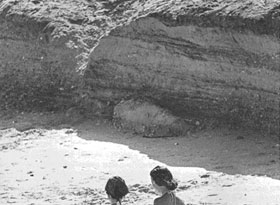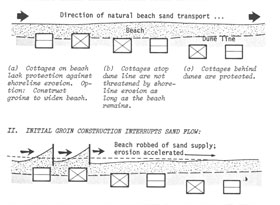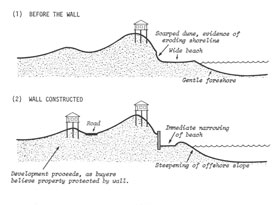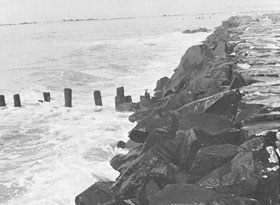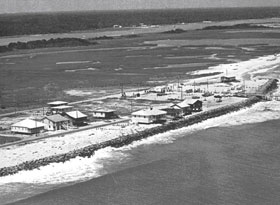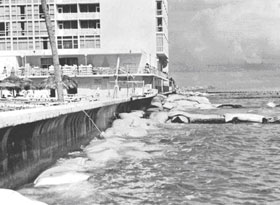Stabilizing The Unstable
Contents
Shoreline engineering is a general phrase that refers to any method of changing or altering the natural shoreline system in order to stabilize it. Methods of stabilizing shorelines range from the simple planting of dune grass to the complex emplacement of large seawalls using draglines, cranes, and bulldozers. The benefits of such methods are usually short-lived. Locally, shoreline engineering may actually cause shoreline retreat, as evidenced by the beach in front of the Carolina Beach seawall. Beach erosion caused by man may be greater and more spectacular than nature’s own.
The ocean-side beaches of North Carolina have fewer engineering mistakes on them than do other states (New Jersey, for example), but this is largely because fewer projects have been carried out; our overall batting average is not too impressive. A few years ago the National Park Service announced that a total of $21 million had been spent to save Outer Banks beaches north and south of Hatteras, but the shoreline continues to retreat. The economic and environmental price of stabilizing the ocean-side beach is stiff indeed. Public awareness of the magnitude of this problem is essential. (There are, of course, situations in which stabilization is an economic necessity. Channels leading to our state ports at Morehead City and Wilmington, for example, must be maintained.)
There are three major ways by which shorelines are stabilized. These methods are listed below, in decreasing order of environmental safety.
Beach Replenishment
If you must repair a beach, this is probably the most gentle approach. Replenishment consists of pumping sand onto the beach and building up the former dunes and upper beach. Sufficient money is never available to replenish the entire beach out to a depth of 40 feet. Thus, only the upper beach is covered with new sand, so that in effect, a steep beach is created (Figure 17). This new steepened profile often increases the rate of erosion. In beach replenishment, sand is either pumped from the lagoon, a pit on the island, or the shelf, but most often from the lagoon. Lagoon sand, however, tends to be too fine; it quickly washes off the beach, as illustrated at Wrightsville Beach. Furthermore, dredging in the lagoon disturbs the ecosystem, and the hole created in the sound affects waves and currents, sometimes harming the back side of the island. In addition, mining the island leaves an unsightly hole of unusable land, as it did near Cape Hatteras in a 1973 replenishment project. Perhaps the best source of sand environmentally, but the most costly, is the continental shelf. However, Dr. Victor Goldsmith of the Virginia Institute of Marine Science warns that when a hole is dug on the shelf for replenishment sand, wave patterns on the adjacent shoreline will likely be affected. Off the Connecticut coast, wave patterns changed by a dredged hole on the shelf quickly caused the replenished beach to disappear.
In 1965 one of North Carolina’s most publicized beach replenishment projects was undertaken at Wrightsville Beach. Nearly 3 million cubic yards of sand were pumped onto 14 thousand feet of beach. Parts of the beach were replenished in 1966 and in 1970, but much of that sand was later lost. In the summer of 1976 the City was worried because the beach had become very steep. A bulldozer was used to flatten the beach slope by pushing sand from the artificial dune out onto the beach. By the summer of 1977 the beach was again very steep and a scarp had formed (Figure 18).
The real problem with beach replenishment, however, comes with cost and sand supply. The cost of the Wrightsville Beach project was over $1 million in 1966. The 1972-3 appropriation to the National Park Service for beach replenishment in the Cape Hatteras-Buxton area was $4.3 million.
Beach replenishment, then, upsets the natural system, is costly, and temporary, requiring subsequent replenishment projects in order to remain effective. The Corps of Engineers refers to beach replenishment as an “ongoing” project, but “eternal” project is perhaps a better term. Nevertheless, beach replenishment is usually less harmful to the total dynamic equilibrium than the following methods.
Groins and Jetties
Groins and jetties are walls built perpendicular to the shoreline. A jetty, often very long (sometimes miles), is intended to keep sand from flowing into a ship channel. Groins, much smaller walls built on straight stretches of beach away from channels and inlets, are intended to trap sand flowing in the longshore (surf-zone) current. There are groins present today on many North Carolina beaches, including Cape Hatteras, Cape Lookout, Bogue Banks, Kure Beach, Fort Fisher, and Yaupon Beach. Groins can be made of wood, stone, concrete, steel, or (increasingly in North Carolina) nylon bags filled with sand. Nylon-bag groins are also common in areas where beaches and property are threatened by inlet migration. The ends of Topsail Beach, Bogue Banks, and Long Beach are examples of such areas.
Both groins and jetties are very successful sand traps. If a groin is working correctly, more sand should be piled up on one side of it than on the other. The problem with the groin is that it traps sand that is probably flowing to a neighboring beach. Thus, if a groin on one beach is functioning well, it must be causing erosion elsewhere by “starving” another beach (Figure 19).
Miami Beach, Florida, illustrates the results of groin usage. After one was built, countless others had to be constructed-in self defense. Prior to the 1977 beach-renourishment project, Miami Beach looked like an Army obstacle course; groins obstructed both pedestrian and vehicular traffic. Groins and other forms of shoreline engineering destroyed Miami Beach. Now, only through an eternal commitment to beach renourishment can the artificial beach be maintained.
Seawalls
Seawalls, built back from and parallel to the shoreline, are designed to receive at least once the full impact of the sea during a tidal cycle. Present in almost every highly developed coastal area, seawalls are fairly common along the North Carolina coast. A more common type of structure in North Carolina is the bulkhead, a type of seawall placed farther from the shoreline in front of the first dune-or what was the first dune-and designed to take the impact of storm waves only. Building a seawall or bulkhead is a very drastic measure on the ocean-side beach, harming the environment in the following ways:
- It reflects wave energy, ultimately removing the beach and steepening the offshore profile. (The length of time required for this damage to occur is one to thirty years.) The steepened offshore profile increases the storm-wave energy striking the shoreline; this in turn increases erosion.
- It increases the intensity of longshore currents, hastening removal of the beach (Figure 20).
- It prevents the exchange of sand between dunes and beach. Thus, the beach cannot supply new sand to the dunes on the island, nor flatten as it tends to do during storms.
- It concentrates wave and current energy at the ends of the wall, increasing erosion at these points.
The emplacement of a seawall is an irreversible act with limited benefits. By gradually removing the beach in front of it, every seawall must eventually be replaced with a bigger (“better”), more expensive one. While a seawall may extend the lives of beach-front structures in normal weather, it cannot protect those on a low-lying barrier island from the havoc wrought by hurricanes; it cannot prevent overwash or storm-surge flooding.
The long-range effect of seawalls can be seen in New Jersey and Miami Beach. In Monmouth Beach, New Jersey, the town building inspector told of the town’s seawall history. Pointing to a seawall he said, “There were once houses and even farms in front of that wall. First we built small seawalls and they were destroyed by the storms that seemed to get bigger and bigger. Now we have come to this huge wall which we hope will hold.” The wall he spoke of, adjacent to the highway, was high enough to prevent even a glimpse of the sea beyond. There was no beach in front of it, but remnants of old seawalls, groins, and bulkheads for hundreds of yards at sea.
A Philosophy of Shoreline Conservation:
“We have met the enemy and he is us.”
In 1801, Postmaster Ellis Hughes of Cape May, New Jersey, placed the following advertisement in the Philadelphia Aurora:
The subscriber has prepared himself for entertaining company who uses sea bathing and he is accommodated with extensive house room with fish, oysters, crabs, and good liquors. Care will be taken of gentlemen’s horses. Carriages may be driven along the margin of the ocean for miles and the wheels will scarcely make an impression upon the sand. The slope of the shore is so regular that persons may wade a great distance. It is the most delightful spot that citizens can go in the hot season.
This was the first beach advertisement in America and sparked the beginning of the American rush to the shore.
In the next 75 years, six Presidents vacationed at Cape May. At the time of the Civil War it was certainly the country’s most prestigious beach resort. The resort’s prestige continued into the 20th century. In 1908, Henry Ford raced his newest model cars on Cape May beaches.
Today, Cape May is no longer found on anyone’s list of great beach resorts. The problem is not that the resort is too old-fashioned, but that no beach remains on the cape (Figure 21).
The following excerpts are quoted from a grant application to the federal government from Cape May City. It was written by city officials in an attempt to get funds to build groins to “save the beaches.” Though it is possible that its pessimistic tone was exaggerated to enhance the chances of receiving funds, its point was clear:
Our community is nearly financially insolvent. The economic consequences for beach erosion are depriving all our people of much needed municipal services …. The residents of one area of town, Frog Hollow, live in constant fear. The Frog Hollow area is a 12 block segment of the town which becomes submerged when the tide is merely 1 to 2 feet above normal. The principal reason is that there is no beach fronting on this area… Maps show that blocks have been lost, a boardwalk that has been lost…. The stone wall, one mile long, which we erected along the ocean front only five years ago has already begun to crumble from the pounding of the waves since there is little or no beach…. We have finally reached a point where we no longer have beaches to erode.
North Carolina will not have to wait a century and a half for this crisis to reach her shores. The pressure to develop is here and increasing. Like the original Cape May resort, our structures are not placed far back from the shore; nor have we been so prudent as to place structures behind dunes or on high ground. Consequently, North Carolina’s coastal development is no less vulnerable to the rising sea than was Cape May’s, and no shoreline engineering device will prevent its ultimate destruction. The solution lies in recognizing certain “truths” about the shoreline.
Truths Of The Shoreline
Cape May is the country’s oldest shoreline resort. Built on a shoreline that migrates much like North Carolina’s, it is a classic example of the poorly developed American shoreline, and one from which North Carolina can learn.
From examples of Cape May and other shoreline areas, certain generalizations or “universal truths” about the shoreline emerge quite clearly. These truths are equally evident to scientists who have studied the shoreline and old-timers who have lived there all of their lives. As aids to safe and aesthetically pleasing shoreline development, they should be the fundamental basis of planning on any barrier island.
- There is no erosion problem until a structure is built on a shoreline. Beach erosion is a common, expected event, not a natural disaster. Shoreline erosion in its natural state is not a threat to barrier islands. It is, in fact, an integral part of island evolution and the dynamic system of the entire barrier island. When a beach retreats it does not mean that the island is disappearing; the island is migrating. Many developed islands are migrating at surprisingly rapid rates, though only the few investigators who pore over aerial photographs are aware of it. Whether the beach is growing or shrinking does not concern the visiting swimmer, surfer, hiker, or fisherman. It is when man builds a “permanent” structure in this zone of change that a problem develops.
- Construction by man on the shoreline causes shoreline changes. The sandy beach exists in a delicate balance with sand supply, beach shape, wave energy, and sea-level rise. This is called the dynamic equilibrium. Most construction on or near the shoreline changes this balance and reduces the natural flexibility of the beach (Figure 22). The result is change which often threatens man-made structures. Dune-removal, which often precedes construction, reduces the sand supply used by the beach to adjust its profile during storms. Beach cottages-even those on stilts-may obstruct the normal sand exchange between the beach and the shelf during storms. Similarly, engineering devices interrupt or modify the natural cycle.
- Shoreline engineering protects the interests of a very few, often at a very high cost in federal and state dollars. Shoreline engineering is carried out to save beach property, not the beach itself. Beach-stabilization projects are in the interest of the minority of beach property owners rather than the public. If the shoreline were allowed to migrate naturally over and past the cottages and hot dog stands, the fisherman and swimmer would not suffer. Yet beach property owners apply pressure for the spending of tax money public funds-to protect the beach. Since these property owners do not constitute the general public, their personal interests do not warrant the large expenditures of public money required for shoreline stabilization. Exceptions to this rule are the beaches near large metropolitan areas. The combination of extensive high rise development and heavy beach use (100,000 or more people per day) affords ample economic justification for extensive and continuous shoreline stabilization projects. The cost of replenishing Wrightsville Beach, for example, is equal to that of replenishing Coney Island, New York, which accommodates tens of thousands more people daily during the summer months. It is more justifiable to spend tax money to replenish the latter beach, since protection of this beach is virtually in the interest of the public that pays for it.
- Shoreline engineering destroys the beach it was intended to save. If this sounds incredible to you, drive to New Jersey or Miami Beach and examine their shores. See the miles of “well protected” shoreline-without beaches! (Figure 23).
- The cost of saving beach property through shoreline engineering is usually greater than the value of the property to be saved. Price estimates are often unrealistically low in the long run for a variety of reasons. Maintenance, repairs, and replacement costs are typically underestimated, because it is erroneously assumed that the big storm, capable of removing an entire beach-replenishment project overnight, will somehow bypass the area. The inevitable hurricane, moreover, is viewed as a catastrophic act of God or a sudden stroke of bad luck for which one cannot plan. The increased potential for damage resulting from shoreline engineering is also ignored in most cost evaluations. In fact, very few shoreline engineering projects would be funded at all if those controlling the purse strings realized that such “lines of defense” must be perpetual.
- Once you begin shoreline engineering, you can’t stop it! This statement, made by a city manager of a Long Island Sound community, is confirmed by shoreline history throughout the world. Because of the long-range damage caused to the beach it “protects,” this engineering must be maintained indefinitely. Its failure to allow the sandy shoreline to migrate naturally results in a steepening of the beach profile, reduced sand supply, and therefore, accelerated erosion. Thus, once man has installed a shoreline structure, “better” -larger and more expensive-structures must subsequently be installed, only to suffer the same fate as their predecessors. History shows us that there are two situations that may terminate shoreline engineering. First, a civilization may fail and no longer build and repair its structures. This was the case with the Romans, who built mighty seawalls. Second, a large storm may destroy a shoreline-stabilization system so thoroughly that people decide to “throw in the towel.” In America, however, such a storm is usually regarded as an engineering challenge and thus results in continued shoreline-stabilization projects. Rubble from two or more generations of seawalls remains off some New Jersey beaches!
The Solutions
- Design to live with the flexible island environment. Don’t fight nature with a “line of defense.”
- Consider all man-made structures near the shoreline temporary.
- Accept as a last resort any engineering scheme for beach restoration or preservation, and then, only for metropolitan areas.
- Base decisions affecting island development on the welfare of the public rather than the minority of shorefront property owners.
- Let the lighthouse, beach cottage, motel, or hot dog stand fall when its time comes.


